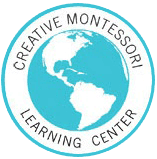Montessori Education
Montessori Style Education in Lombard, IL
The Montessori approach to early childhood education
is based on the method of seeing children as they really are and of creating environments which foster the fulfillment of their highest potential - spiritual, emotional, physical, and intellectual.
Dr. Maria Montessori based her method of teaching upon the spontaneous interest of children in learning. This gives each child the freedom and opportunity to explore the self-learning environment and find the circumstances which are most appropriate to his/her own particular stage of development. The Montessori classroom is thus centered on the activity of the child, not that of the teacher.
The Curriculum Areas in a Montessori Classroom -- there are four major areas and several adjunct areas:
Practical Life Exercises
Acquisition of coordination of movement and independence through fine-motor and gross-motor activities.
Sensorial Activities
Sharpen the perceptual skills of the child while indirectly preparing for writing and reading through a wide variety of sensory motor exercises.
Math Exercises
Development of a mathematical mind through indirect and direct preparation for arithmetic and geometry via manipulative materials leading to number and measurement precepts and concepts.
Language and Communication Skills
Phonics via sandpaper letters, matching exercises leading to sound and visual recognition of letters and words, the building of words via the "Movable Alphabet," oral communication, hand-eye writing control exercises which allow her/him to blossom into reading.
Dr. Maria Montessori based her method of teaching upon the spontaneous interest of children in learning. This gives each child the freedom and opportunity to explore the self-learning environment and find the circumstances which are most appropriate to his/her own particular stage of development. The Montessori classroom is thus centered on the activity of the child, not that of the teacher.
The Curriculum Areas in a Montessori Classroom -- there are four major areas and several adjunct areas:
Practical Life Exercises
Acquisition of coordination of movement and independence through fine-motor and gross-motor activities.
Sensorial Activities
Sharpen the perceptual skills of the child while indirectly preparing for writing and reading through a wide variety of sensory motor exercises.
Math Exercises
Development of a mathematical mind through indirect and direct preparation for arithmetic and geometry via manipulative materials leading to number and measurement precepts and concepts.
Language and Communication Skills
Phonics via sandpaper letters, matching exercises leading to sound and visual recognition of letters and words, the building of words via the "Movable Alphabet," oral communication, hand-eye writing control exercises which allow her/him to blossom into reading.
Montessori Style Education in Lombard, IL
The Montessori approach to early childhood education
is based on the method of seeing children as they really are and of creating environments which foster the fulfillment of their highest potential - spiritual, emotional, physical, and intellectual.
Dr. Maria Montessori based her method of teaching upon the spontaneous interest of children in learning. This gives each child the freedom and opportunity to explore the self-learning environment and find the circumstances which are most appropriate to his/her own particular stage of development. The Montessori classroom is thus centered on the activity of the child, not that of the teacher.
The Curriculum Areas in a Montessori Classroom -- there are four major areas and several adjunct areas:
Practical Life Exercises
Acquisition of coordination of movement and independence through fine-motor and gross-motor activities.
Sensorial Activities
Sharpen the perceptual skills of the child while indirectly preparing for writing and reading through a wide variety of sensory motor exercises.
Math Exercises
Development of a mathematical mind through indirect and direct preparation for arithmetic and geometry via manipulative materials leading to number and measurement precepts and concepts.
Language and Communication Skills
Phonics via sandpaper letters, matching exercises leading to sound and visual recognition of letters and words, the building of words via the "Movable Alphabet," oral communication, hand-eye writing control exercises which allow her/him to blossom into reading.
Dr. Maria Montessori based her method of teaching upon the spontaneous interest of children in learning. This gives each child the freedom and opportunity to explore the self-learning environment and find the circumstances which are most appropriate to his/her own particular stage of development. The Montessori classroom is thus centered on the activity of the child, not that of the teacher.
The Curriculum Areas in a Montessori Classroom -- there are four major areas and several adjunct areas:
Practical Life Exercises
Acquisition of coordination of movement and independence through fine-motor and gross-motor activities.
Sensorial Activities
Sharpen the perceptual skills of the child while indirectly preparing for writing and reading through a wide variety of sensory motor exercises.
Math Exercises
Development of a mathematical mind through indirect and direct preparation for arithmetic and geometry via manipulative materials leading to number and measurement precepts and concepts.
Language and Communication Skills
Phonics via sandpaper letters, matching exercises leading to sound and visual recognition of letters and words, the building of words via the "Movable Alphabet," oral communication, hand-eye writing control exercises which allow her/him to blossom into reading.
Content, including images, displayed on this website is protected by copyright laws. Downloading, republication, retransmission or reproduction of content on this website is strictly prohibited. Terms of Use
| Privacy Policy
